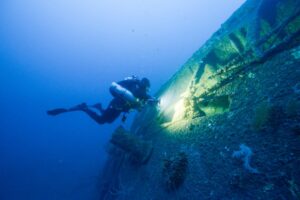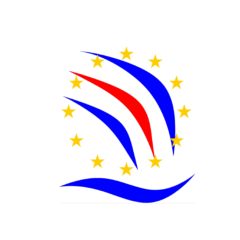The search for the needle in the haystack
More than 8,000 potentially dangerous shipwrecks lie at the bottom of our oceans. More than 1,500 are tankers. More than two-thirds originate from the Second World War. The majority of them must be regarded as acutely dangerous to marine flora and fauna. 70.7% of the earth’s surface or 360,570,000 km² are covered by water. Even if we make our wildest dreams come true quickly and send 100 research ships in the medium term, each of them will have 80 wrecks scattered over an area ten times the size of Germany to search for, find, investigate and decontaminate.
Fortunately, the situation is not as hopeless as it seems! The – at least approximate – position of many wrecks is known, which significantly limits the search effort. The majority lies in moderate depths in the epipelagic (up to 200m). Unfortunately, this is also the most “sensitive” area of the oceans. This epipelagic zone is also the focus of our activities.

During a preliminary search we try to narrow down their positions as precisely as possible. The search area thus defined is analysed step by step with acoustic location. For this purpose, we tow side-scan sonars behind our boats, which – using linked GPS positioning – produce extremely high-resolution maps of the sea floor. Under good conditions we can search an area of one square kilometer per hour for wrecks. If we find something “suspicious” we send a diving robot also called ROUV (remotely operated underwater vehicle) down. If a find is confirmed, we try to identify the wreck. This is usually easiest if you dive it directly. Depending on the depth this can be done with air and open circuit or with mixed gas in a closed circuit rebreather (see: Technical Research Diving). Once a wreck has been identified, the rights must be negotiated with the owners. Until then it is generally not allowed to enter the wreck – at least not officially.
Of course it is also necessary to keep the position absolutely a secret in order not to endanger our negotiating position. However, the vast majority of wrecks from the world wars do not contain gold or other treasures, but mainly oil, ammunition and scrap metal. Therefore, in general, we do not expect an over-interest in the ownership rights of the flag states (because this would mean that they would recognise their responsibility for the toxins). However, there are materials on many wrecks which at first glance do not look precious, but which are nevertheless quite valuable and can thus also contribute to covering the decontamination costs, keyword: low-background steel / lead. However, before wrecks can be searched for at all, research vessels have to be built, exploration and diving equipment has to be purchased, and crew members have to undergo extensive training for their future special missions.
When a research vessel finally sets sail, running costs have to be covered such as maintenance and repairs, harbour fees, insurance, consumables, diving gases and, above all, the crew must be able to earn a living. To be able to finance all this, it is necessary to commercialise one aspect of shipwrecks, namely the diving and salvage rights. Shipwrecks are a real magnet for sport and Tec divers, the more unexplored the more interesting. And it is precisely this fact that enables us to decontaminate them. There are more than 20 million recreational divers worldwide. They need to be reached, they need to be involved in the search, exploration and decontamination of the wrecks. The vast majority of them are not yet aware of the problem! To detect and identify this incredible number of shipwrecks many ambitious, professional crew members and effective tools are needed. This is exactly why we have decided to build our boats and ships ourselves in a sustainable and environmentally friendly way. More about this topic under Ship yard.
Coastal cleanups

During our dives we have always come across large amounts of other garbage on the seabed and of course on the coasts and beaches. So far, we have organised beach cleanups several times a year and also picked up ghost nets, car tires, kitchen stoves and sometimes even whole cars from the seabed. We are one of the few organisations that are able to reach depths beyond the usual recreational diving limit of 40-45 meters. So, with our experienced specialists, we can take care of the seabed up to a depth of more than 100 meters.
